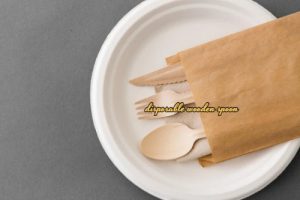Do you know the variety of household tableware?
- by reallymake
- November 12, 2021
Material classification of tableware
1. Ceramic tableware
Ceramic tableware, the traditional view of ceramics refers to disposable wooden spoon all wild industrial products that use clay and other organic non-metallic minerals as raw materials. It contains various finished products made of clay or a mixture containing clay through mixing, forming, and sintering. From the crudest earthenware to the most exquisite pottery and ceramics belong to its limitations. The primary material for it is silicate minerals (such as clay, feldspar, quartz, etc.) derived from nature, so it belongs to the field of "silicate industry" with industries such as glass, cement, enamel, and refractory materials. The firing and application of ceramic tableware has a long history in our country. It has a variety of appearances, beautiful colors, cool and smooth feel, easy to wash, and is deeply admired by Chinese people. The manufacturing essentials of ceramic tableware are divided into three types: over-glaze, under-glaze, and in-glaze. On-glaze colored ceramics are made of decorative paper made of pigments and attached to the surface of the glaze or indirectly painted on the appearance of the product with pigments, and then baked at a high temperature, because the baking temperature does not reach the level of melting of the glaze layer, so the flower surface is not Can't sink into the glaze. Touch the on-glaze ceramics with your hands, and you will feel that the flower surface has obvious unevenness; the firing temperature of the in-glaze ceramics can melt the glaze, and the pigments can sink into the glaze. After cooling, they will be covered by the glaze layer. The surface of the product is smooth and handy. There is no obvious bumpy feeling to the touch; all the underglaze ceramics are decorated on the porcelain blank, and after the glaze is fired at a high temperature, the flower surface is covered by the glaze layer, which looks bright, flat and smooth to the touch.
2. Glass tableware
The flaws of glass tableware are fragile. If used improperly, it can easily cause explosion. The glass tableware is clean and hygienic and does not contain toxic materials. However, the glass tableware will occasionally "mould" because the glass is corroded by water for a long time. The reaction of the sodium silicate and the carbon dioxide in the atmosphere produces white carbonic acid crystals, which are harmful to human health, so it can be removed with alkaline detergents during use.
3. Enamel tableware
The finished enamel has good machine strength, knots, is not easy to break, and has good heat resistance, which can withstand relatively limited temperature changes. The texture is bright, not easy to infect dust, and it is clean and durable. The disadvantage of enamel products is that they tend to crack and break after being impacted by external forces. The outer layer of the enamel product is actually a layer of enamel, which contains substances such as aluminum silicate. If it is damaged, it will be transferred to the food. Therefore, when buying enamel tableware, the surface should be smooth and flat, the enamel should be uniform, the color should be bright, and there should be no transparent foundation and embryo phenomenon.
4. Wooden tableware
Various utensils and utensils used for distributing or ingesting food. It includes a complete set of bowls, chopsticks, knives, forks, plates, plates, trays, wooden shovel, wooden spoons, wooden scoops, rice steaming, as well as various containers and hand-held utensils of various uses. Generally, chopsticks are the most common for bamboo and wood tableware, and bamboo tableware is divided into bamboo tableware and wooden tableware according to the manufacturing materials. The biggest advantage of bamboo and wood tableware is that it is environmentally friendly and green, it is convenient to obtain materials and does not have the toxic effects of chemical materials. At the beginning, more and more people in the world used it. All bamboo and wood tableware are made of bamboo or solid wood. They are exquisite and unique. They are not only practical, but also have artistic embellishment value. They are both practical and artistic decoration effect when placed at home. But their weakness is that they are more likely to be contaminated and moldy than other tableware. If you do not pay attention to disinfection, it is easy to cause intestinal infectious diseases.
Related articles recommended
Talking about environmental protection, but still using wooden chopsticks?
